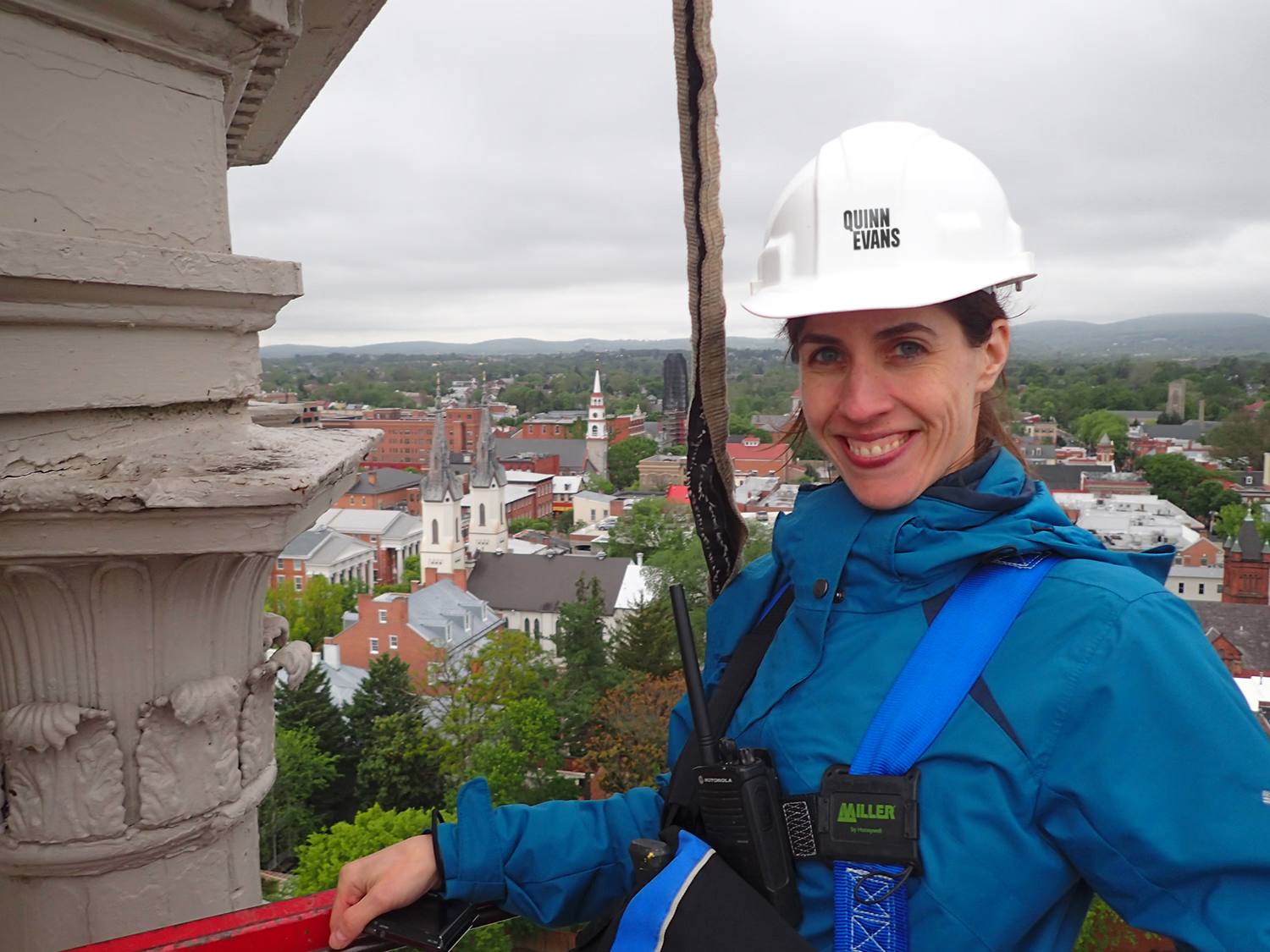You may know that cultural landscape reports (CLRs) provide an in-depth discussion of how a landscape has changed over time, but did you know they also aim to protect the site far into the future?
In today’s changing climate, preparing a site for an uncertain future involves planning for resilience against extreme weather events. With our CLRs, we seek to go one step further: we recommend sustainability measures that will help enhance ecosystem services and ecological functions. This is part of our commitment to advancing climate action and social equity through the transformation of the built environment.

What is a cultural landscape?
Cultural landscapes result from the interaction between human beings and their environment. These landscapes are shaped by the built structures, agricultural practices, religious rituals, and social and economic activities that have taken place there. A major part of a CLR is the documentation of this history.
In addition to documenting past and present conditions, CLRs also provide recommendations for the treatment of the landscape: improvements to the way it is maintained or to its physical features. Our treatment recommendations incorporate sustainable practices that will allow the landscape to withstand and adapt to the impacts of climate change, natural disasters, or the changing needs of the community. Strategies such as water conservation, energy efficiency, and ecological restoration help protect a site’s historic features for the long term—both by increasing the landscape’s resilience and by lessening its carbon footprint.
Our CLR for the Ohio and Erie Canal at Cuyahoga Valley National Park (downloadable here) is a prime example of a report that both documents the place’s past and prepares it for the future.

A rich history
The Ohio and Erie Canal was once a critical piece of transportation infrastructure that spurred agricultural and commercial development across the Cuyahoga Valley in northeast Ohio. In more recent years, the canal and its cultural landscape have come under the protection of the National Park Service (NPS) as part of the Cuyahoga Valley National Park.
NPS’s goal in commissioning the CLR is to preserve and protect the cultural landscape of the canal corridor and establish conditions that help visitors visualize its history and function while balancing long-term maintenance, regional recreation, and sustainability within the Cuyahoga River watershed.
The Cuyahoga Valley region has a rich history of human habitation dating back over 12,000 years. Multiple Indigenous tribes and nations inhabited the region, and some of their earthen structures, burial mounds, and trails remain. Others have been damaged over time by factors including agriculture and development.
In the 18th century, while Indigenous populations still controlled the area, French trading posts were established and German missionaries also visited the area. After Ohio achieved statehood in 1803, more settlements began to appear in the Cuyahoga Valley, populated primarily by subsistence farmers with limited connections to regional markets due to the remoteness of the area.
Inspired by the success of New York's Erie Canal, Ohio's leaders advocated for canal development to improve trade connections with New York. A route following the Cuyahoga River to Lake Erie was selected for its suitability for water supply, and construction began on July 4, 1825. By the time of its completion in October 1832, the Ohio & Erie Canal stretched 308.14 miles from Lake Erie at Cleveland to the Ohio River at Portsmouth, including a 38-mile stretch within the Cuyahoga Valley, rising 395 feet above lake level with 44 locks.
The development of the canal led to speculative development along its routes and significant population growth in towns like Akron and Cleveland. Agricultural development also followed, and other towns adapted to serve the growing workforce and take advantage of the new trade route.
The canal’s decline began soon after it was completed, with the opening of the Pennsylvania and Ohio / Mahoning Canal in 1840, which ended the Ohio-Erie monopoly on transporting goods. The rapid development of railroads in the 1850s further contributed to the canal's demise, and it was finally abandoned following a massive flood in 1913.

Planning for change
In the years since its abandonment as a transportation route, the section of the canal that runs through the Cuyahoga Valley has continued to be a popular place for recreation and was eventually incorporated into Cuyahoga Valley National Park. However, expanding development, heavy recreational use, invasive vegetation, and lack of upkeep degraded the condition of the canal over the 100 years since its abandonment. Working with NPS, QE hosted a series of focus group meetings and conducted field investigations to identify opportunities within the landscape to preserve existing canal components and to find ways to enhance visitor understanding of the importance and historical function of the site.
Our CLR presents a vision for the canal that weaves historic preservation with contemporary needs. It champions innovative strategies to preserve and protect the canal corridor cultural landscape, visualizing its history and function while balancing long-term maintenance, regional recreation, and sustainability. We developed the CLR’s treatment plan in collaboration with NPS staff to craft recommendations that align with the Secretary of the Interior's Standards for the Treatment of Historic Properties as well as current visitor use, accessibility, stormwater management, and dredging regulations.
In the canal's northern segment, the plan emphasizes the National Historic Landmark's historic condition to boost integrity, condition, and interpretation. Future treatment will rehabilitate concrete and stone structures, such as the locks and spillways, to support the active maintenance of water in the canal prism.
Efforts in the southern sections of the canal corridor focus on enhancing the canal's visibility and revealing its function to Towpath Trail visitors. Thoughtful approaches are tailored for high-use nodes along the corridor, aiming to mitigate congestion, improve universal access, clarify historical contexts, and honor the multifaceted narrative of these spaces.

Integrating sustainable practices
Our treatment plan in this CLR proposes retaining water within the prism where possible, particularly to support the creation of vernal pools. Water retained within the prism would evoke the historic character of the landscape and also provide valuable amphibian habitat, support stormwater retention, and reduce the burden on traditional stormwater infrastructure in the area.
The towpath treatment also illustrates the importance of sustainability in the context of cultural landscapes. We recommend a rustic visual appearance for the path, with irregular edges, a coarse texture, and an earth-toned color that matches the natural soil in the area. The selected chip seal surface has the appearance of crushed stone but the durability of asphalt, supporting maintenance and recreational use while visually representing the historic character of the towpath.
The plan also calls for historic vegetation patterns to be represented along the towpath, incorporating native plants and accommodating trees for shade.
Knitting the cultural landscape back into its ecosystem
Beyond documenting historic features, CLRs present a unique opportunity to implement sustainable practices that enhance the resilience of a landscape. By leveraging the rich history of a site, we can create places that celebrate the past, adapt to the present, and prepare for the future.
Cultural landscape projects encompass both tangible and intangible elements; appropriate and sustainable treatment allows us to reflect on our cultural identity and collective memory while restoring the natural environment. As we look forward to the realization of our treatment plan, we are reminded of the Ohio & Erie Canal's enduring legacy—not just as a relic of the past but as a living landscape that serves as a connective thread throughout northeastern Ohio.


.avif)





